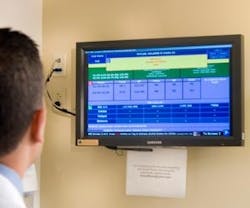Hospital Smart Rooms are Ready for Rollout
Whether designing a new hospital or updating an existing one, as an architect, you must remember that clinical workflow is a critical consideration for efficiency, total cost of ownership, and improved clinical quality in a healthcare facility.
At the University of Pittsburgh Medical Center (UPMC), a “smart” patient room has been created that organizes and simplifies the workflow of front-line staff. At the same time, this system makes retrieving the right patient information at the right time as simple as walking into the room for the clinician. The ultimate goal: safe and reliable care, higher patient satisfaction, improved efficiency, and lower costs.
Using real-time location tracking technology, the Smart Room identifies healthcare workers as they enter the room and provides the relevant clinical information needed at the bedside. The system includes a detector in the room, as well as ultrasound tags worn by healthcare workers that emit an inaudible sound that can be heard only by the detector. When a caregiver walks into the room, the system identifies the person wearing the ultrasound tag and displays that person’s name and role on a monitor for the patient to see. (That wall-mounted monitor is also used as the patient’s television and the place where patient education, testing schedules, e-mails from family and friends, games, and other patient-friendly features are delivered.)
The Smart Room gathers role-specific information about the patient from the patient’s electronic medical records to be displayed on a second monitor for the caregiver. A doctor, for instance, will see different data than a nurse or a housekeeper. For example, a phlebotomist who needs to draw blood from the patient sees only current lab orders and allergy information. The “home screen” of the system represents the patient at a glance, with key information, such as allergies and precautions that the caregiver needs to do his or her job safely. Real-time clinical information is a few touches away. From medications due to vital signs and allergies, information is displayed so the caregivers know the patient’s status immediately.
The Smart Rooms allow care team members to access relevant patient information quickly. Features are built into the Smart Room to protect patient confidentiality as well (if someone who isn’t authorized to view certain information comes into the room, the staff member can press a button to quickly hide the data). These Smart Rooms also document each time a caregiver visits the room. If needed, there are records that can be displayed about how often patients are checked on by staff members.
Through a simple, touchscreen interface, a nurse or other caregiver can document the completion of work in just a few seconds rather than writing down that information and waiting to batch-document later. Even using a computer on wheels requires a login and sorting through multiple screens to get to the right place, and they pose the added risk of spreading unwanted micro-organisms. With UPMC’s solution, it has essentially closed the time and space gap for documentation, improving quality and efficiency.
The latest addition to the Smart Room’s functionality is an algorithm that evaluates all of a caregiver’s tasks for each patient. It determines which are the most important to complete at any point in time. A workflow analytics module is being built to alert the unit manager when routine work is falling behind, including an objective analysis of workload and a simple view to help the care team support one another without a lot of meeting time and discussion.
To further refine the Smart Room, UPMC is using a former nursing unit that’s been transformed into a design and simulation center. In this 10-bed space, a team of clinicians and IT specialists work out the step-by-step details and human-factors issues essential to successful implementation. It’s important to understand that the technology used in the Smart Room is simply the means to the end – solving the everyday problems of healthcare, which may or may not require some newly invented technology.
After three years of development, the Smart Room is a commercially viable product, ready for a broader rollout at UPMC and at other healthcare providers. And as the recent healthcare reform debate has underscored, our industry is desperately in need of solutions to reduce costs, improve quality, and provide consistency and reliability. UPMC believes that, with the Smart Room, it can help to meet that challenge.
David Sharbaugh is a senior director in the Donald D. Wolff Jr. Center for Quality Improvement and Innovation at the University of Pittsburgh Medical Center (UPMC). Michael Boroch is part of the Smart Room leadership team.
